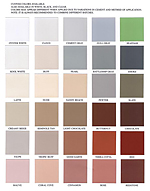Maintenance

1. Why should I seal my pavers?
Sealing the pavers protects the bricks from dirt, oil, and anything that may penetrate the pores. It also protects the color of the brick from fading due to sun exposure. The sealer also enhances the color in the brick.2. How should my pavers be cleaned?
Pavers should always be pressure cleaned before sealing. Our process uses an acid based detergent (not muriatic acid ) for the chemical wash, then using a 4,000 psi commercial pressure cleaner to remove any existing dirt, stains, sand, etc., that may be present.3. How should my pavers be sealed?
After the correct process of pressure cleaning, pavers as well as base sand need to be 100% dry in order to apply sealer. Usually the drying process takes approx: 1 day. (depending on weather). Sealer is then applied with an airless sprayer. 2 coats are sprayed on. SEALER SHOULD NEVER BE ROLLED ON. Drying time of the sealer is 24 hours for vehicular traffic, and 45 minutes to 1 hr. for light foot traffic.4. Do my pavers need more than 2 coats of sealer?
Usually on new pavers, 2 coats is sufficient enough to protect the pavers. In some instances, if pavers have been down for a while, and never sealed before, a 3rd coat may be needed. This is determined by our sealer technicians after 2nd coat is applied. Applying more than necessary may result in pavers turning a milky white color due to excessive amount of sealer. Sealer is to protect the paver, not necessarily to make them shiny. The shinyness comes from the acrylic in the sealer. The amount of shine will depend on the color. Light colors tend to shine less than darker colors.5. How can I determine if my pavers have been sealed correctly?
After pavers are sealed, any liquid that may fall on pavers will bead off. If the proper amount of sealer was not applied, you will not have the beading off of water or other liquids.6. Do pavers need to be re-sanded?
The mason sand should remain approx: 1/2 way down the brick for correct interlocking. The sand does not need to be all the way to top. Purpose of mason sand is to keep bricks from shifting. Depending on the type of brick and the tightness between them, after the pressure cleaning process, you will be able to see if more sand is needed.7. Why should pavers not be sealed when wet?
When pavers are sealed wet, the moisture is trapped between the paver and the sealer. The moisture is trapped, and is not able to dry. In turn, the moisture turns a milky white color.8. How do I fix the milky white discoloration?
In most cases, a sealer reducer will be applied to release moisture. After drying, a light coat of sealer can be reapplied. If there is an excessive amount of sealer, pavers must be waterblasted to remove all existing sealer. Then pavers can be re-pressure cleaned, and resealed with the proper amount of sealer. Waterblasting does not harm the brick, including the texture and color if done properly. Waterblasting is a costly process, and it may benefit the consumer to compare pricing with replacing material as an alternative.9. How long does the cleaning & sealing process take?
Usually cleaning & sealing is a 2 day process. The first day is the chemical wash, and pressure cleaning. The 2nd day is the sealing process. Scheduling is always WEATHER PERMITTING. Pavers must be 100% dry in order to apply sealer. If the pavers are not dry enough to seal, it may take an additional day or two to have the sealer applied. 1" pavers usually take a bit longer than full size bricks due to overlaying on concrete.10. What type of sealer is used on pavers?
There are many sealers available to the public. We recommend that an acrylic oil based sealer is used. A sealer that is specifically made for pavers. Concrete sealer is not the correct sealer to use.11. Does sealing prevent weeds from growing?
No. It may help, but normal spraying of weed killer is the most effective way. Weed killer will not harm the paver or the sealer.12. What exactly is color sealing?
Color sealing uses a solvent base colored stain that is mixed in with our clear sealer. The application process is the same as regular sealing. The color sealing gives the pavers a solid color look. Usually, color sealing is used when pavers have been down for a long time, and the colors have faded due to sun exposure. The stain only comes in solid colors, but custom colors are available.
Click here to enlarge
Area We Service:
Broward County:Coconut Creek, Cooper City, Coral Springs, Dania Beach, Davie, Deerfield Beach, Fort Lauderdale (County Seat), Hallandale Beach, Hillsboro Beach, Hollywood, Lauderdale Lakes, Lauderdale-By-The-Sea, Lauderhill, Lazy Lake, Lighthouse Point, Margate, Miramar, North Lauderdale, Oakland Park, Parkland, Pembroke Park, Pembroke Pines, Plantation, Pompano Beach, Port Everglades, Sea Ranch Lakes, Southwest Ranches, Sunrise, Tamarac, West Park, Weston, Wilton Manors
Palm Beach County:
Atlantis, Belle Glade, Boca Raton, Boynton Beach, Briny Breezes, Canal Point, Cloud Lake, Delray Beach, Glen Ridge, Golf, Greenacres, Gulf Stream, Haverhill, Highland Beach, Hypoluxo, Juno Beach, Jupiter, Jupiter Inlet Colony, Lake Clarke Shores, Lake Park, Lake Worth, Lantana, Loxahatchee, Manalapan, Mangonia Park, North Palm Beach, Ocean Ridge, Pahokee, Palm Beach, Palm Beach Gardens, Palm Beach Shores, Palm Springs, Riviera Beach, Royal Palm Beach, Sandcut, South Bay, South Palm Beach, Tequesta, Wellington, West Palm Beach
Martin County:
Arundel, Indiantown, Hobe Sound, Hutchinson Island South, Jensen Beach, Jupiter Island, Ocean Breeze Park, Palm City, Sewall's Point, Stuart








